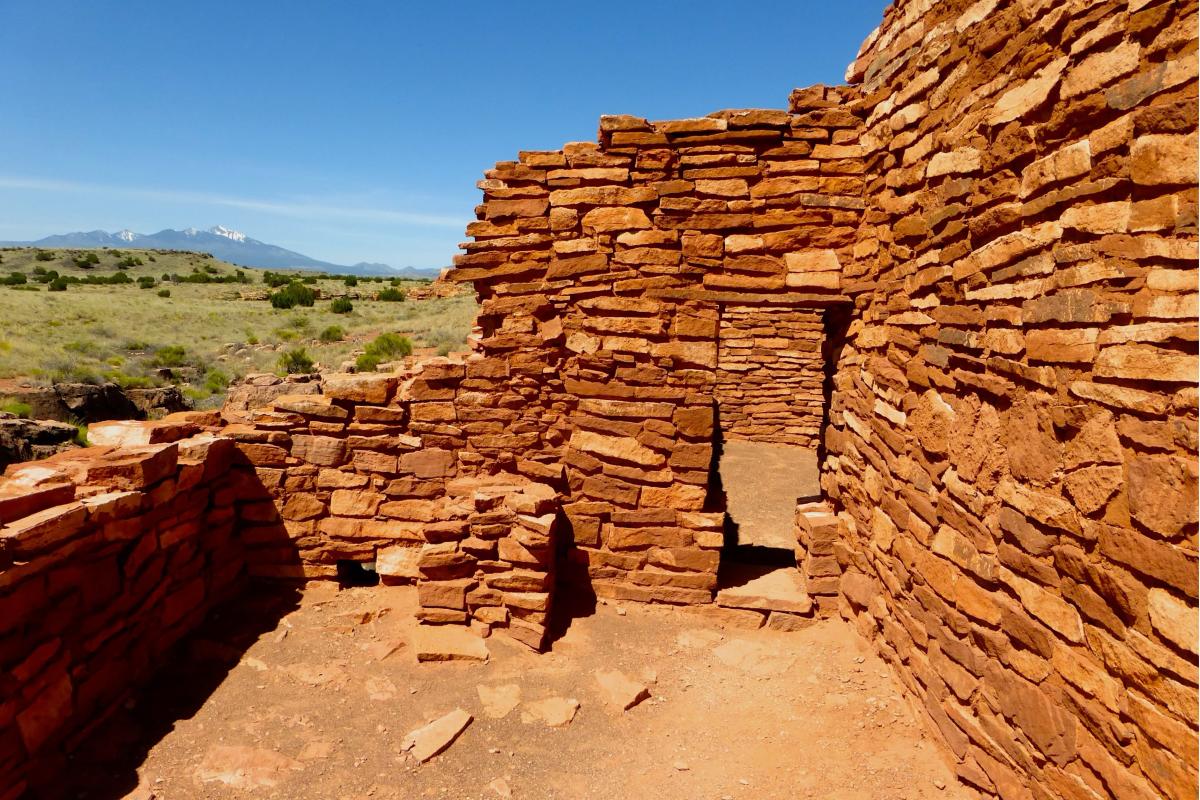The blowhole gets me every time.
I love the story of Wupatki National Monument and the sweeping vistas that stretch across miles of rolling prairie northeast of Flagstaff. I love the aching quiet while hiking to the smaller pueblos that rise like red-boned ghosts above swaying grasses. But it’s a weird geological feature that always intrigues me. The blowhole connects me to the past.
The dwellings at Wupatki were the work of the Ancestral Puebloans, including the Cohonina, Kayenta, and Sinagua cultures. They were constructed from thin blocks of Moenkopi sandstone, giving them their distinctive red color. Most were built more than 900 years ago.
Behind the visitor center, a paved trail curves past Wupatki Pueblo, the largest structure in the park. The sprawling three-story village straddles an outcropping of sandstone. Down the slope, near a ceremonial ballcourt is the blowhole, where air is forced upward by underground pressure. It’s like feeling the earth breathe. The blowhole expels a blast of deliciously cool air that slices through a hot summer morning.
I sit there listening to the soft freight train whoosh roaring through underground chambers and sampling that fountain of wind. More than the dwellings, signage, or artifacts, the blowhole helps me see those who resided here. I envision them after a spirited bout on the ballcourt hurrying over to this little fracture in the ground. There was probably some playful shoving as they jockeyed for position. Then smiles and laughter as they leaned over the opening taking a refreshing blast of chilled air right in the face.
How miraculous it must have seemed. It still does to me, all these centuries later.
On December 9, 2024, Wupatki celebrates its centennial. President Calvin Coolidge established Wupatki National Monument in 1924 to protect the abundant archaeological resources. So now is the perfect time to visit.
When the Sky Fell

It started with a cataclysm.
The eruption of Sunset Crater (above) bent and broke the landscape of Northern Arizona in 1085. Indigenous people fled their pit houses with the first rumbling earthquakes. Then came the explosions. A barrage of lava, ash, and cinders spewed forth in what must have felt like the end of the world.
Yet just a few years later, the people came back. Not to the scorched land surrounding the volcano, but to the arid region 20 miles north. Here they began constructing stone pueblos. A period of increased rainfall followed the eruptions, and the layer of volcanic ash that had fallen added nutrients to the soil. It helped the ground absorb moisture and prevented evaporation. Dry terrain suddenly turned arable and farming communities sprang up across the plains. Today we know these villages as Wupatki National Monument.
Villages of Stone

There’s no place in Arizona like Wupatki. Larger dwellings can be found in the state, but none feel as animate. These are free-standing structures. Instead of being hidden away in canyons or cliff alcoves, the multi-story masonry pueblos are rooted in the landscape, worn and weathered like natural formations, and pinned beneath an ever-changing sky.
Short pathways lead to these ancient structures built from sandstone and mud in the 1100s. While more than 2,500 archaeological sites have been catalogued within the monument, only a handful are accessible to visitors.
Wupatki Pueblo is the largest freestanding pueblo in Northern Arizona, a three-story structure containing 100 rooms. Once a regional center of trade, Wupatki features a circular community room, a ballcourt, which happens to be the northernmost ballcourt ever discovered, and a blowhole. By 1182, approximately 85 to 100 people lived at Wupatki Pueblo.
Others include Wukoki Pueblo, anchored by a square tower three-stories tall, Citadel and Nalakihu Pueblos, and my favorites, the lonely Lomaki and Box Canyon Pueblos, weathered remnants perched on the rocky edge of a narrow gorge.
By the mid-1200s, the Ancestral Puebloans left the Wupatki Basin for still undetermined reasons. An ongoing drought, decreased food supplies as the soil became unproductive, and disruption to their trade networks are all possible causes for departure. They are thought to have traveled east, merging with other pueblo tribes on the Colorado Plateau. Hopi people refer to the Ancestral Puebloans as Hisatsinom, or “people of long ago.”
Although the ruins are no longer physically occupied, Hopi believe the people who lived and died at Wupatki remain as spiritual guardians. The pueblos are remembered and cared for, not abandoned.
Roger Naylor is an Arizona travel writer and author. His latest book is Arizona National Parks and Monuments: Scenic Wonders and Cultural Treasures of the Grand Canyon State. He is a member of the Arizona Tourism Hall of Fame and narrator of Verde Canyon Railroad. For more info, visit www.rogernaylor.com.





